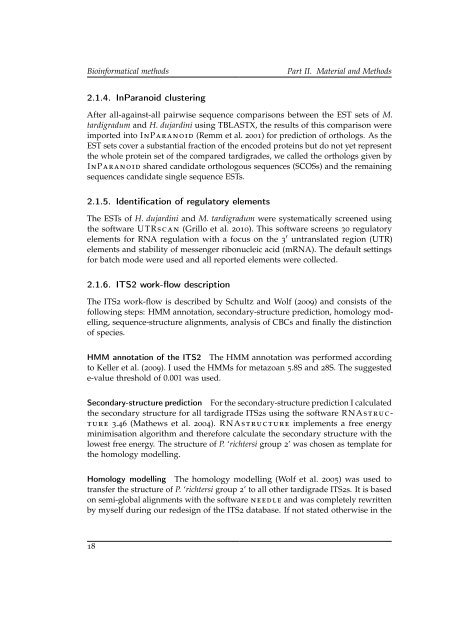Making the most of phylogeny - OPUS - Universität Würzburg
Making the most of phylogeny - OPUS - Universität Würzburg
Making the most of phylogeny - OPUS - Universität Würzburg
You also want an ePaper? Increase the reach of your titles
YUMPU automatically turns print PDFs into web optimized ePapers that Google loves.
Bioinformatical methods Part II. Material and Methods<br />
2.1.4. InParanoid clustering<br />
After all-against-all pairwise sequence comparisons between <strong>the</strong> EST sets <strong>of</strong> M.<br />
tardigradum and H. dujardini using TBLASTX, <strong>the</strong> results <strong>of</strong> this comparison were<br />
imported into InParanoid (Remm et al. 2001) for prediction <strong>of</strong> orthologs. As <strong>the</strong><br />
EST sets cover a substantial fraction <strong>of</strong> <strong>the</strong> encoded proteins but do not yet represent<br />
<strong>the</strong> whole protein set <strong>of</strong> <strong>the</strong> compared tardigrades, we called <strong>the</strong> orthologs given by<br />
InParanoid shared candidate orthologous sequences (SCOSs) and <strong>the</strong> remaining<br />
sequences candidate single sequence ESTs.<br />
2.1.5. Identification <strong>of</strong> regulatory elements<br />
The ESTs <strong>of</strong> H. dujardini and M. tardigradum were systematically screened using<br />
<strong>the</strong> s<strong>of</strong>tware UTRscan (Grillo et al. 2010). This s<strong>of</strong>tware screens 30 regulatory<br />
elements for RNA regulation with a focus on <strong>the</strong> 3 ′ untranslated region (UTR)<br />
elements and stability <strong>of</strong> messenger ribonucleic acid (mRNA). The default settings<br />
for batch mode were used and all reported elements were collected.<br />
2.1.6. ITS2 work-flow description<br />
The ITS2 work-flow is described by Schultz and Wolf (2009) and consists <strong>of</strong> <strong>the</strong><br />
following steps: HMM annotation, secondary-structure prediction, homology modelling,<br />
sequence-structure alignments, analysis <strong>of</strong> CBCs and finally <strong>the</strong> distinction<br />
<strong>of</strong> species.<br />
HMM annotation <strong>of</strong> <strong>the</strong> ITS2 The HMM annotation was performed according<br />
to Keller et al. (2009). I used <strong>the</strong> HMMs for metazoan 5.8S and 28S. The suggested<br />
e-value threshold <strong>of</strong> 0.001 was used.<br />
Secondary-structure prediction For <strong>the</strong> secondary-structure prediction I calculated<br />
<strong>the</strong> secondary structure for all tardigrade ITS2s using <strong>the</strong> s<strong>of</strong>tware RNAstructure<br />
3.46 (Ma<strong>the</strong>ws et al. 2004). RNAstructure implements a free energy<br />
minimisation algorithm and <strong>the</strong>refore calculate <strong>the</strong> secondary structure with <strong>the</strong><br />
lowest free energy. The structure <strong>of</strong> P. ‘richtersi group 2’ was chosen as template for<br />
<strong>the</strong> homology modelling.<br />
Homology modelling The homology modelling (Wolf et al. 2005) was used to<br />
transfer <strong>the</strong> structure <strong>of</strong> P. ‘richtersi group 2’ to all o<strong>the</strong>r tardigrade ITS2s. It is based<br />
on semi-global alignments with <strong>the</strong> s<strong>of</strong>tware needle and was completely rewritten<br />
by myself during our redesign <strong>of</strong> <strong>the</strong> ITS2 database. If not stated o<strong>the</strong>rwise in <strong>the</strong><br />
18

















